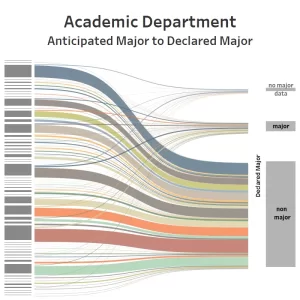Department & Program Assessment
First, why?
Assessment has gained popularity these days, but those of us in education know we have been doing it for decades, centuries, maybe an eternity. We are constantly assessing knowledge and skills, sharing information and ideas, and developing our own professional expertise and contribution. This may be done in our intellectual reflections or with formal scoring tools or a myriad of places in between.
At Bates, we believe great things are happening in the learning experiences of students, faculty, staff and administration. One reason we are assessing is to document this greatness. Another reason is to see what we need to do to maintain this greatness. And there are times and people for whom learning experiences are not so great, so we need to understand and improve in those ways as well. A few voices from the field about why we are assessing can be heard in the list of links below:
Why are we assessing? – Linda Suskin, Middle States Commission on Higher Education
An Accreditor’s View of Assessment – AAC&U
Assessment for Whom? – Wall, Hursh & Rodgers, 2014
If you decide to engage in department or program assessment/evaluation, Bates IRAP can help your department or program through every step of the process! Feel free to connect with Kika Stump at any time about how we can support this important work.
Here are some suggestions for department/program assessment to begin your process…
Department/Program Learning Goals, Objectives, Outcomes
Many academic departments and programs at Bates College have communicated their learning goals and/or objectives within their webpages. The college has also shared its overall mission, goals and aims in various documents, including the Institutional Plan. In addition to these examples of departmental/program or institutional learning goals at Bates, the following list offers a highlight of external samples and related resources:
Assessment Plan & Inventory – Leech Lake Tribal College (2016)
What Faculty Unions Say… – NILO (Gold, et al., 2011)
Program Learning Goals & Objectives – St. Joseph’s University
Understanding Where You Are (Using Data)
Once members of the department/program identify their key department/program goals or “burning questions,” they can combine them with existing resources (inputs) and offerings (activities) to articulate outcomes. This information can be collected and communicated to build a common understanding of the needs and current situation of the program/department. A tool for visualizing and organizing this process is a logic model. Bates IRAP has also developed a template logic model used by various departments and programs at our college.
Outcomes can be categorized as measurable or non-measurable in a specific assessment. Non-measurable outcomes may require data that is not currently available, such as post-graduation achievements or life-long learning. Measurable outcomes can be assessed with various types of data and tools. Bates IRAP can support data selection and collection by…
- identifying the types of existing unit-level institutional data available (enrollment, demographics, honors thesis, senior survey, first-year survey)
- exploring methods for collecting empirical data (focus groups, surveys, individual interviews, self-assessments, curriculum mapping, document review)
- conducting data collection and analysis
- creating data visualizations and reports of data results
We can also support your work by sharing ideas and resources to facilitate your next steps of planning improvement. One method for engaging in this process with academic units may include curriculum mapping.
Curriculum Mapping
Once academic units and faculty have developed learning goals and objectives, a next step is to map the learners’ pathways through their educational experience to examine their interaction with these objectives. Mapping also creates transparency, so students may answer questions such as, ‘Why would I want to take this course?’ or ‘Why would I want to major in this discipline?’
Curriculum mapping in itself does not guarantee great educational experiences, but it can be a tool to better reflect on learners’ experiences and explicate opportunities for students.
Curriculum Mapping: A Conceptual Framework & Practical Illustration (Matveev et al., 2010)
Curriculum Mapping in Higher Education… (Arafeh, 2015)
Curriculum Mapping in Higher Education… (Pippin Uchiyama & Radin, 2008)
Curriculum Mapping Tools & Instructions – Carnegie Mellon University
Calculus Student Outcomes Curricular Mapping – Bates Math Dept
To begin your department/program curricular mapping, you may copy this template: Unit-level Curriculum Map Template. Bates IRAP can also utilize institutional data to examine students’ pre-college interests, course-taking patterns, academic performance, and selection of majors/minors in pathway analysis as seen in the sample below.
For more resources, information or ways in which Bates IRAP can support assessment in your program or department, contact Kika Stump at estump@bates.edu.